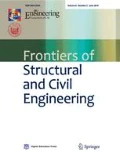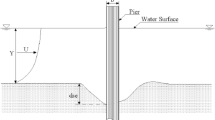Abstract
Scour depth around bridge piers plays a vital role in the safety and stability of the bridges. The former approaches used in the prediction of scour depth are based on regression models or black box models in which the first one lacks enough accuracy while the later one does not provide a clear mathematical expression to easily employ it for other situations or cases. Therefore, this paper aims to develop new equations using particle swarm optimization as a metaheuristic approach to predict scour depth around bridge piers. To improve the efficiency of the proposed model, individual equations are derived for laboratory and field data. Moreover, sensitivity analysis is conducted to achieve the most effective parameters in the estimation of scour depth for both experimental and filed data sets. Comparing the results of the proposed model with those of existing regression-based equations reveal the superiority of the proposed method in terms of accuracy and uncertainty. Moreover, the ratio of pier width to flow depth and ratio of d50 (mean particle diameter) to flow depth for the laboratory and field data were recognized as the most effective parameters, respectively. The derived equations can be used as a suitable proxy to estimate scour depth in both experimental and prototype scales.
Similar content being viewed by others
References
Zounemat-Kermani M, Beheshti A A, Ataie-Ashtiani B, Sabbagh-Yazdi S R. Estimation of current-induced scour depth around pile groups using neural network and adaptive neuro-fuzzy inference system. Applied Soft Computing, 2009, 9: 746–755
Azamathulla H M, Ghani A A. ANFIS-based approach for predicting the scour depth at culvert outlets. Journal of pipeline systems engineering and practice, 2010, 2: 35–40
Richardson E, Davis S. Evaluating Scour at Bridges: Hydraulic Engineering Circular. FHWA-IP-90-017, HEC-18. 2001
Johnson P A. Reliability-based pier scour engineering. Journal of Hydraulic Engineering, 1992, 118: 1344–1358
Melville B W, Chiew Y M. Time scale for local scour at bridge piers. Journal of Hydraulic Engineering, 1999, 125: 59–65
Bateni S M, Borghei S, Jeng D S. Neural network and neuro-fuzzy assessments for scour depth around bridge piers. Engineering Applications of Artificial Intelligence, 2007, 20: 401–414
Azamathulla H M, Ghani A A, Zakaria N A, Guven A. Genetic programming to predict bridge pier scour. Journal of Hydraulic Engineering, 2009, 136: 165–169
Pal M, Singh N, Tiwari N. M5 model tree for pier scour prediction using field dataset. KSCE Journal of Civil Engineering, 2012, 16: 1079–1084
Liao K W, Lu H J, Wang C Y. A probabilistic evaluation of pierscour potential in the Gaoping River Basin of Taiwan. Journal of Civil Engineering and Management, 2015, 21: 637–653
Sharafi H, Ebtehaj I, Bonakdari H, Zaji A H. Design of a support vector machine with different kernel functions to predict scour depth around bridge piers. Natural Hazards, 2016, 84: 2145–2162
Alizadeh M J, Ahmadyar D, Afghantoloee A. Improvement on the existing equations for predicting longitudinal dispersion coefficient. Water Resources Management, 2017, 31: 1777–1794
Mottahedi A, Sereshki F, Ataei M. Overbreak prediction in underground excavations using hybrid ANFIS-PSO model. Tunnelling and Underground Space Technology, 2018, 80: 1–9
Sreedhara B, Mandal S. Soft Computing for Problem Solving. New York: Springer, 2019, 455–463
Al-Musawi A A. Determination of shear strength of steel fiber RC beams: Application of data-intelligence models. Frontiers of Structural and Civil Engineering, 2019, 13(3): 667–673
Wang Z X, Li Q. Modelling the nonlinear relationship between CO2 emissions and economic growth using a PSO algorithm-based grey Verhulst model. Journal of Cleaner Production, 2019, 207: 214–224
Ghodsi H, Beheshti A A. Evaluation of harmony search optimization to predict local scour depth around complex bridge piers. Civil Engineering Journal, 2018, 4: 402–412
Basser H, Karami H, Shamshirband S, Akib S, Amirmojahedi M, Ahmad R, Jahangirzadeh A, Javidnia H. Hybrid ANFIS-PSO approach for predicting optimum parameters of a protective spur dike. Applied Soft Computing, 2015, 30: 642–649
Fallah S, Deo R, Shojafar M, Conti M, Shamshirband S. Computational intelligence approaches for energy load forecasting in smart energy management grids: State of the art, future challenges, and research directions. Energies, 2018, 11: 596
Laucelli D, Giustolisi O. Scour depth modelling by a multi-objective evolutionary paradigm. Environmental Modelling & Software, 2011, 26: 498–509
Najafzadeh M, Shiri J, Rezaie-Balf M. New expression-based models to estimate scour depth at clear water conditions in rectangular channels. Marine Georesources and Geotechnology, 2018, 36: 227–235
Tinoco R, Goldstein E, Coco G. A data-driven approach to develop physically sound predictors: Application to depth-averaged velocities on flows through submerged arrays of rigid cylinders. Water Resources Research, 2015, 51: 1247–1263
Mohamed T A, Pillai S, Noor M J M M, Ghazali A H, Huat B, Yusuf B. Validation of some bridge pier scour formulae and models using field data. Journal of King Saud University-Engineering Sciences, 2006, 19: 31–40
Johnson P, Clopper P, Zevenbergen L, Lagasse P. Quantifying uncertainty and reliability in bridge scour estimations. Journal of Hydraulic Engineering, 2015, 141: 04015013
Benedict S T, Caldwell A W. A Pier-Scour Database: 2,427 Field and Laboratory Measurements of Pier Scour. Report number: Data Series 84. 2014
Eberhart R, Kennedy J. A new optimizer using particle swarm theory. In: Proceedings of the Sixth International Symposium on Micro Machine and Human Science. New York, 1995
Laursen E M, Toch A. Scour Around Bridge Piers and Abutments. Ames, IA: Iowa Highway Research Board, 1956
El-Saiad A A. Local scour around bridge piers. Engineering Research Journal, 1998, 57: 129–137
Riahi-Madvar H, Dehghani M, Seifi A, Salwana E, Shamshirband S, Mosavi A, Chau K W. Comparative analysis of soft computing techniques RBF, MLP, and ANFIS with MLR and MNLR for predicting grade-control scour hole geometry. Engineering Applications of Computational Fluid Mechanics, 2019, 13(1): 529–550
Melville B, Sutherland A. Design method for local scour at bridge piers. Journal of Hydraulic Engineering, 1988, 114: 1210–1226
Mohamed T A, Noor M, Ghazali A H, Huat B B. Validation of some bridge pier scour formulae using field and laboratory data. American Journal of Environmental Sciences, 2005, 1: 119–125
Acknowledgements
This research was supported by the Hungarian State and the European Union under the EFOP-3.6.1-16-2016-00010 project and the 2017-1.3.1-VKE-2017-00025 project.
Author information
Authors and Affiliations
Corresponding author
Rights and permissions
About this article
Cite this article
Shamshirband, S., Mosavi, A. & Rabczuk, T. Particle swarm optimization model to predict scour depth around a bridge pier. Front. Struct. Civ. Eng. 14, 855–866 (2020). https://doi.org/10.1007/s11709-020-0619-2
Received:
Accepted:
Published:
Issue Date:
DOI: https://doi.org/10.1007/s11709-020-0619-2




